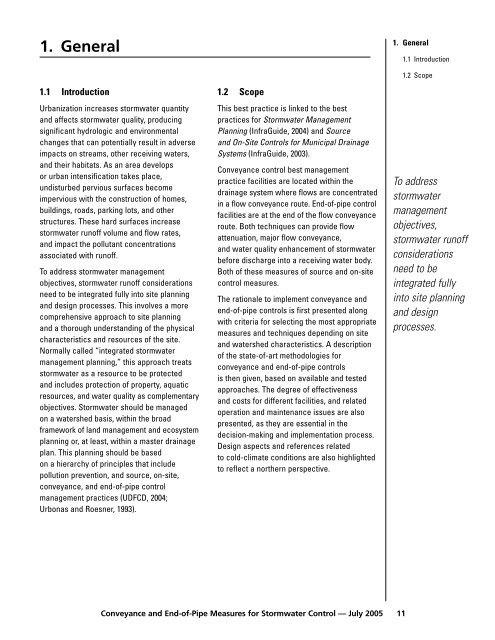Conveyance and End-of-Pipe Measures for Stormwater - FCM
Conveyance and End-of-Pipe Measures for Stormwater - FCM
Conveyance and End-of-Pipe Measures for Stormwater - FCM
Create successful ePaper yourself
Turn your PDF publications into a flip-book with our unique Google optimized e-Paper software.
1. General<br />
1.1 Introduction<br />
Urbanization increases stormwater quantity<br />
<strong>and</strong> affects stormwater quality, producing<br />
significant hydrologic <strong>and</strong> environmental<br />
changes that can potentially result in adverse<br />
impacts on streams, other receiving waters,<br />
<strong>and</strong> their habitats. As an area develops<br />
or urban intensification takes place,<br />
undisturbed pervious surfaces become<br />
impervious with the construction <strong>of</strong> homes,<br />
buildings, roads, parking lots, <strong>and</strong> other<br />
structures. These hard surfaces increase<br />
stormwater run<strong>of</strong>f volume <strong>and</strong> flow rates,<br />
<strong>and</strong> impact the pollutant concentrations<br />
associated with run<strong>of</strong>f.<br />
To address stormwater management<br />
objectives, stormwater run<strong>of</strong>f considerations<br />
need to be integrated fully into site planning<br />
<strong>and</strong> design processes. This involves a more<br />
comprehensive approach to site planning<br />
<strong>and</strong> a thorough underst<strong>and</strong>ing <strong>of</strong> the physical<br />
characteristics <strong>and</strong> resources <strong>of</strong> the site.<br />
Normally called “integrated stormwater<br />
management planning,” this approach treats<br />
stormwater as a resource to be protected<br />
<strong>and</strong> includes protection <strong>of</strong> property, aquatic<br />
resources, <strong>and</strong> water quality as complementary<br />
objectives. <strong>Stormwater</strong> should be managed<br />
on a watershed basis, within the broad<br />
framework <strong>of</strong> l<strong>and</strong> management <strong>and</strong> ecosystem<br />
planning or, at least, within a master drainage<br />
plan. This planning should be based<br />
on a hierarchy <strong>of</strong> principles that include<br />
pollution prevention, <strong>and</strong> source, on-site,<br />
conveyance, <strong>and</strong> end-<strong>of</strong>-pipe control<br />
management practices (UDFCD, 2004;<br />
Urbonas <strong>and</strong> Roesner, 1993).<br />
1.2 Scope<br />
This best practice is linked to the best<br />
practices <strong>for</strong> <strong>Stormwater</strong> Management<br />
Planning (InfraGuide, 2004) <strong>and</strong> Source<br />
<strong>and</strong> On-Site Controls <strong>for</strong> Municipal Drainage<br />
Systems (InfraGuide, 2003).<br />
<strong>Conveyance</strong> control best management<br />
practice facilities are located within the<br />
drainage system where flows are concentrated<br />
in a flow conveyance route. <strong>End</strong>-<strong>of</strong>-pipe control<br />
facilities are at the end <strong>of</strong> the flow conveyance<br />
route. Both techniques can provide flow<br />
attenuation, major flow conveyance,<br />
<strong>and</strong> water quality enhancement <strong>of</strong> stormwater<br />
be<strong>for</strong>e discharge into a receiving water body.<br />
Both <strong>of</strong> these measures <strong>of</strong> source <strong>and</strong> on-site<br />
control measures.<br />
The rationale to implement conveyance <strong>and</strong><br />
end-<strong>of</strong>-pipe controls is first presented along<br />
with criteria <strong>for</strong> selecting the most appropriate<br />
measures <strong>and</strong> techniques depending on site<br />
<strong>and</strong> watershed characteristics. A description<br />
<strong>of</strong> the state-<strong>of</strong>-art methodologies <strong>for</strong><br />
conveyance <strong>and</strong> end-<strong>of</strong>-pipe controls<br />
is then given, based on available <strong>and</strong> tested<br />
approaches. The degree <strong>of</strong> effectiveness<br />
<strong>and</strong> costs <strong>for</strong> different facilities, <strong>and</strong> related<br />
operation <strong>and</strong> maintenance issues are also<br />
presented, as they are essential in the<br />
decision-making <strong>and</strong> implementation process.<br />
Design aspects <strong>and</strong> references related<br />
to cold-climate conditions are also highlighted<br />
to reflect a northern perspective.<br />
<strong>Conveyance</strong> <strong>and</strong> <strong>End</strong>-<strong>of</strong>-<strong>Pipe</strong> <strong>Measures</strong> <strong>for</strong> <strong>Stormwater</strong> Control — July 2005 11<br />
1. General<br />
1.1 Introduction<br />
1.2 Scope<br />
To address<br />
stormwater<br />
management<br />
objectives,<br />
stormwater run<strong>of</strong>f<br />
considerations<br />
need to be<br />
integrated fully<br />
into site planning<br />
<strong>and</strong> design<br />
processes.
















